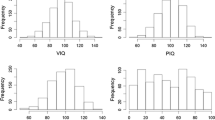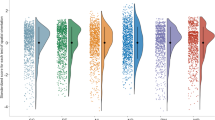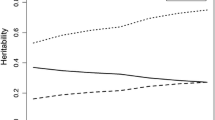Abstract
Eleven tests of specific cognitive abilities were administered to 108 pairs of young twins (average age of 7.6 years). Internal consistencies are high for all measures except Raven's Coloured Progressive Matrices and Delayed Picture Memory. Two-month, test-retest reliabilities are also reported. The twin sample is representative in terms of both means and variances when compared to normative data from standardization samples, and twin correlations for height and weight are similar to those obtained in six other twin studies. Because all measures were highly correlated with age (average correlation with age was 0.64), scores were age adjusted. Previous twin studies of specific cognitive abilities in adolescents and adults found genetic variance for nearly all tests. In contrast, our study of young twins yielded significant genetic influence for only 1 of the 11 measures, PIAT Reading Recognition, and suggested the possibility of genetic influence on 2 others (vocabulary and WISC-R mazes). Environmental influences seem to dominate, particularly for nonverbal measures, as children begin their education. In accord with other studies, we found that between-family environmental factors have an important influence on the development of nearly all of the measures of specific cognitive abilities. However, we found that our tests of perceptual speed and memory were substantially influenced by within-family environmental factors independent of error.
Similar content being viewed by others
References
Cohen, D. J., Dibble, E., Grawe, J. M., and Pollin, W. (1973). Separating identical from fraternal twins.Arch. Gen. Psychiat. 29:465–469.
Cohen, D. J., Dibble, E., Grawe, J. M., and Pollin, W. (1975). Reliably separating identical from fraternal twins.Arch. Gen. Psychiat. 32:1371–1375.
DeFries, J. C., Vandenberg, S. G., and McClearn, G. E. (1976). The genetics of specific cognitive abilities.Annu. Rev. Genet. 10:179–207.
DeFries, J. C., Singer, S. M., Foch, T. T., and Lewitter, F. I. (1978). Familial nature of reading disability.Br. J. Psychiat. 132:361–367.
DeFries, J. C., Johnson, R. C., Kuse, A. R., McClearn, G. E., Polovina, J., Vandenberg, S. G., and Wilson, J. R. (1979). Familial resemblance for specific cognitive abilities.Behav. Genet. 9:23–43.
Dunn, L. M., and Markwardt, F. C. (1970).Peabody Individual Achievement Test Manual, American Guidance Service, Circle Pines, Minn.
Garfinkle-Claussner, A. S. (1979). Genetic and environmental influences on the development of Piagetian logico-mathematical concepts and other specific cognitive abilities: A twin study. Unpublished doctoral dissertation, University of Colorado, Boulder.
Grotevant, H. D., Scarr, S., and Weinberg, R. A. (1977). Intellectual development in family constellations with adopted and natural children: A test of the Zajonc and Markus model.Child Dev. 48:1699–1703.
Guilford, J. P., and Fruchter, B. (1973).Fundamental Statistics in Psychology and Education, 5th ed., McGraw-Hill, New York.
Harman, H. H., Ekstrom, R. B., and French, J. W. (1976).Kit of Factor Reference Cognitive Tests, Education Testing Service, Princeton, N.J.
Ho, H-Z., Foch, T. T., and Plomin, R. (1980). Developmental stability of the relative influence of genes and environment on specific cognitive abilities during childhood.Dev. Psychol. 16:340–346.
Knaack, R. (1978). A note on the usefulness of the Coloured Progressive Matrices (CPM) with preschool children.Psycol. Erziehung Unterricht 25:159–167.
Koch, H. L. (1966).Twins and Twin Relations, The University of Chicago Press, Chicago.
Loehlin, J. C., and Nichols, R. C. (1976).Heredity, Environment and Personality, Austin University Press, Texas.
McCarthy, D. (1972).Manual for the McCarthy Scales of Children's Abilities, The Psychological Corp., New York.
Mittler, P. (1971).The Study of Twins, Penguin Books, England.
Nichols, R. C., and Bilbro, W. C. (1966). The diagnosis of twin zygosity.Acta Genet. 16:265–275.
Plomin, R., and DeFries, J. C. (1980). Genetics and intelligence: Recent data.Intelligence 4:15–24.
Plomin, R., and Foch, T. T. (1980). A comparison between children diagnosed as hyperactive and a control group on objective personality measures and specific cognitive abilities.J. Abnorm. Child Psychol. (in press).
Plomin, R., and Vandenberg, S. G. (1980). An analysis of Koch's (1966) Primary Mental Abilities test data for 5- to 7-year-old twins.Behav. Genet. 10:409–412.
Plomin, R., DeFries, J. C., and McClearn, G. E. (1980).Behavioral Genetics: A Primer, W. H. Freeman, San Francisco.
Raven, J. C. (1965).Guide to Using the Coloured Progressive Matrices, Grieve the Printers, London.
Roberts, R. C. (1979). Side effects of selection for growth in laboratory animals.Livestock Product. Sci. 6:93–104.
Scott, J. P., and Fuller, J. L. (1965).Genetics and the Social Behavior of the Dog, University of Chicago Press, Chicago.
Wechsler, D. (1974).Manual for the Wechsler Intelligence Scale for Children (revised), The Psychological Corp., New York.
Wilson, J. R., DeFries, J. C., McClearn, G. E., Vandenberg, S. G., Johnson, R. C., and Rashad, M. N. (1975). Cognitive abilities: Use of family data as a control to assess sex and age differences in two ethnic groups.Int. J. Aging Hum. Dev. 6:261–276.
Wilson, R. S. (1975). Twins: Patterns of cognitive development as measured on the Wechsler Preschool and Primary Scales of Intelligence.Dev. Psychol. 11:126–134.
Wilson, R. S. (1976). Concordance in physical growth for monozygotic and dizygotic twins.Ann. Human Biol. 3:1–10.
Wilson, R. S. (1978). Synchronies in mental development: An epigenetic perspective.Science 202:939–948.
Woodcock, R. W. (1976).Goldman-Fristoe-Woodcock Auditory Skills Test Battery Technical Manual, American Guidance Service, Circle Pines, Minn.
Author information
Authors and Affiliations
Additional information
This work was supported by a grant from the Spencer Foundation.
Rights and permissions
About this article
Cite this article
Foch, T.T., Plomin, R. Specific cognitive abilities in 5- to 12-year-old twins. Behav Genet 10, 507–520 (1980). https://doi.org/10.1007/BF01066220
Received:
Accepted:
Issue Date:
DOI: https://doi.org/10.1007/BF01066220




